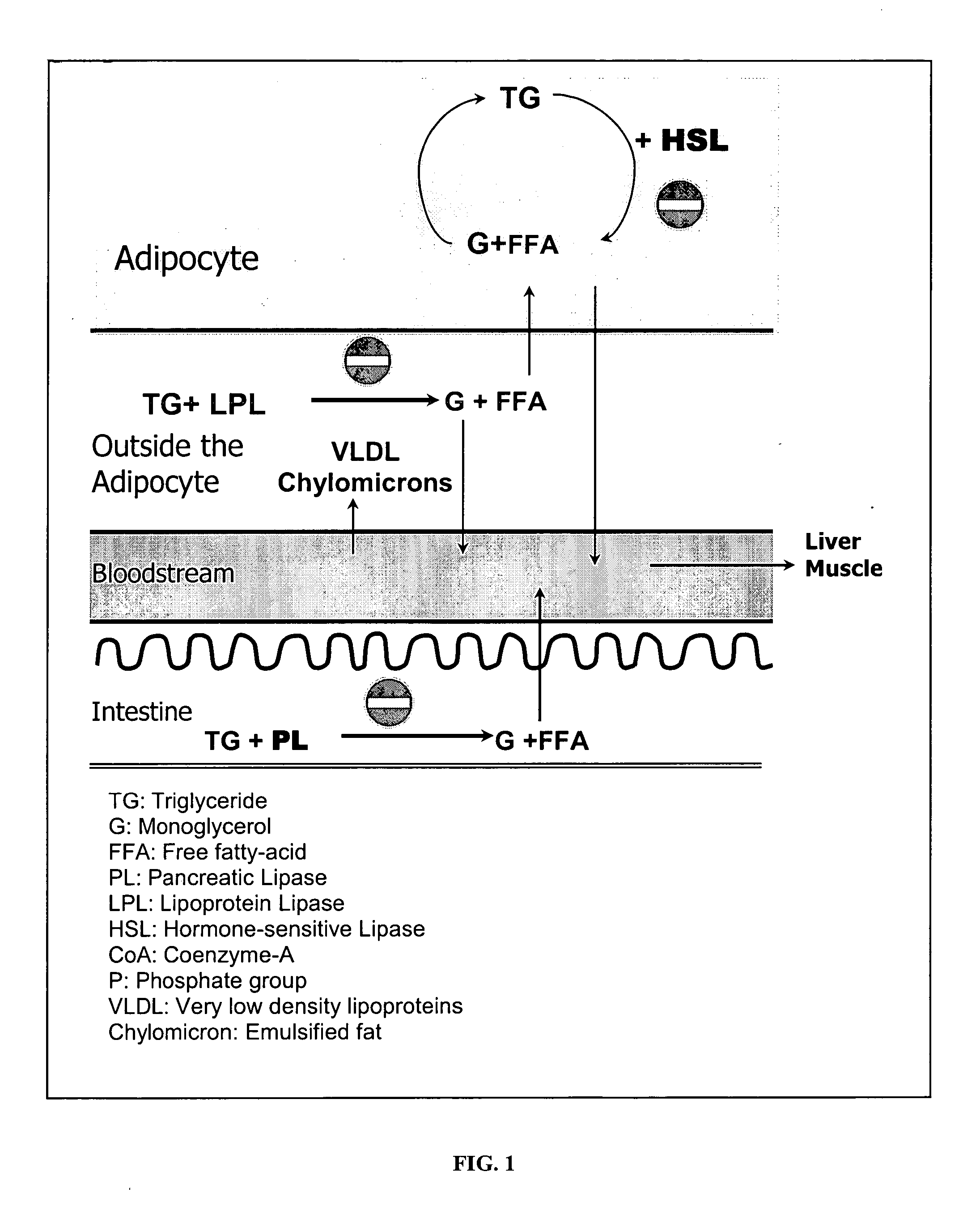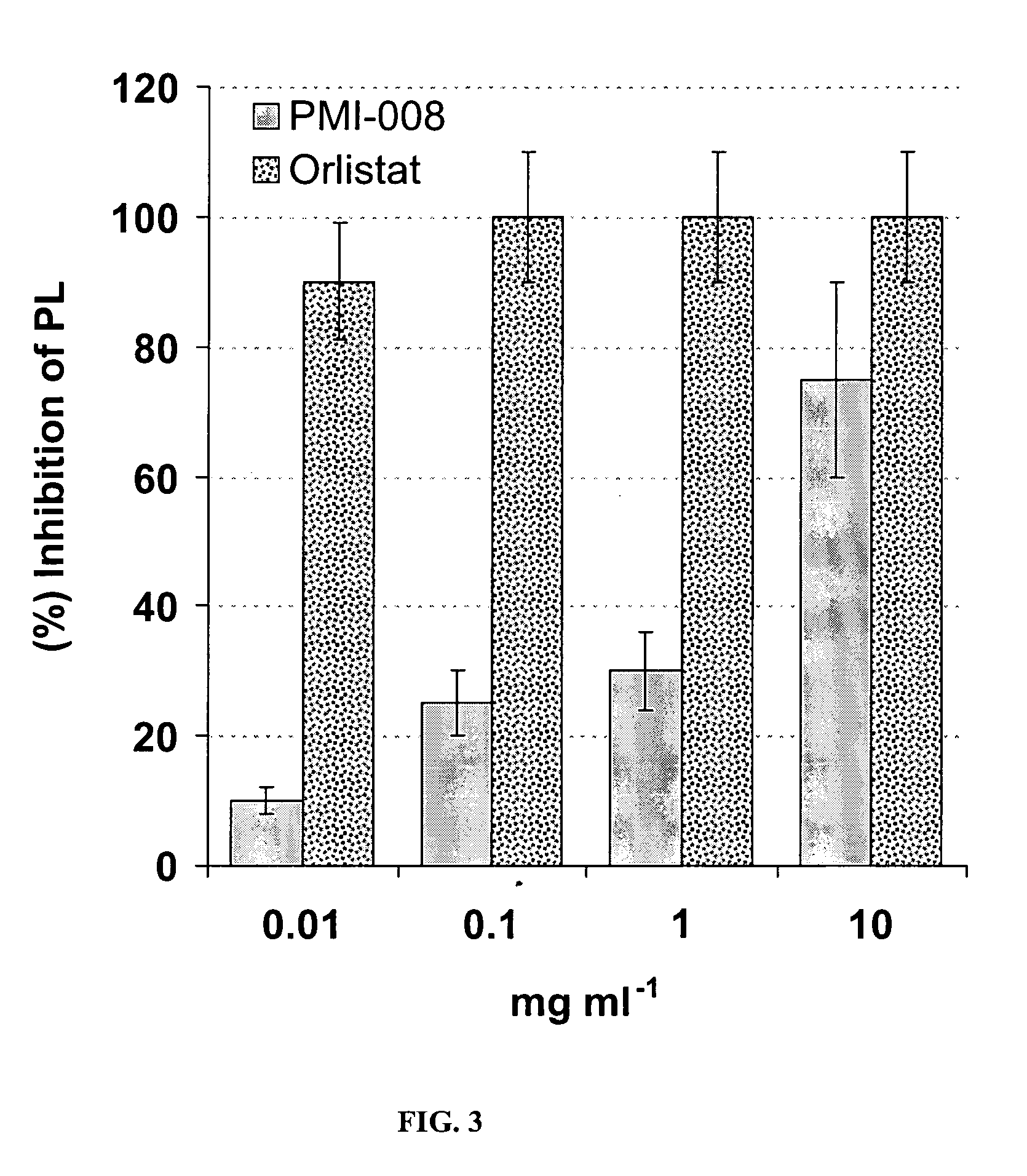Phytomedicinal compositions for the control of lipid accumulation and metabolism in mammals
a technology of lipid accumulation and compositions, applied in the field of botanical compositions for therapeutic purposes, can solve the problems of increasing obesity and the failure of most available treatments in long-term maintenance of medically significant weight loss, and achieve the effect of prevention and/or treatmen
- Summary
- Abstract
- Description
- Claims
- Application Information
AI Technical Summary
Benefits of technology
Problems solved by technology
Method used
Image
Examples
example i
[0053] A Pancreatic Lipase (PL) inhibitory test was performed with a commercial kit (Lipase-PS™ Trinity Biotech USA, Jamestown, N.Y.). Lipase-PS™ reagents were obtained from Trinity Biotech USA (Lipase-PS™ was manufactured by Sigma Diagnostics (Procedure No. 805, Sigma-Aldrich, St. Louis, Mo. until 2003)). Human pancreatic lipase (Lipase-PS standard, 230-248 U / L) was obtained from (Sigma-Aldrich, St. Louis, Mo.). Aliquots (30 μL) of lipase standard, blank (water as reference), and extracts from organs and plant parts shown in Table 1 were added to 500 μL of reconstituted substrate solution and mixed gently and incubated for 5 min. at 37° C. Activator reagent (300 μL) was added and mixed by gentle inversion and the samples were incubated again for 3 min. at 37° C. The recorded rate of increase in absorbance at 550 nm due to the formation of quinone diimine dye was used to determine the pancreatic lipase activity in the samples prepared, as detailed in the literatur...
example 11
Lipoprotein Lipase
[0055] A Lipoprotein Lipase (LPL) inhibition is measured following an adaptation of the Nilsson-Ehle & Schotz (1976) as detailed in Moreno et al. 2003. Nilsson-Ehle P., Schotz M. C., A Stable, Radioactive Substrate Emulsion for Assay of Lipoprotein Lipase, J. Lipid Res, 17:546 (1976). A pool of LPL is made by incubating human adipose tissue fragments with 10 U / ml heparin (500 mg / 5 ml) for 45 minutes at 24° C. Aliquots of this heparin eluate are preincubated with varying concentrations of 0.001, 0.01, 0.1, and 1 mg / ml of botanical extracts for 30 minutes, at 4° C. After addition of 3H-triolein substrate containing albumin and human serum as a source of apolipoprotein CII, samples are incubated for 60 minutes at 37° C. Released 3H-oleic acid is extracted and measured.
[0056] Inhibitory action of PMI-008 on in vitro Lipoprotein Lipase (LPL) activity using Example II is shown in FIG. 4.
example iii
Hormone Sensitive Lipase
[0057] HSL activity is determined by measuring glycerol released from murine 3T3-L1 adipocytes using a fluorometeric assay. Lipolytic activity in cultured mouse 3T3-L1 adipocytes was used as measure of HSL activity. 3T3-L1 cells were cultured, as described in Brasaemle, et al., (1997) and Moreno et al. 2003 in DMEM (4500 mg glucose / liter) supplemented with 10% fetal bovine serum, 2 mM glutamine, 100 units / ml penicillin, 100 μg / ml streptomycin, 110 μg / ml sodium pyruvate, and 8 μg / ml biotin, in a 5% CO2 atmosphere at 37° C. Brasaemle, D. L., et al., Adipose Differentiation-Related Protein is an Ubiquitously Expressed Lipid Storage Droplet-Associated Protein, J Lipid Res., 38, 2249 (1997). Cells were maintained in dishes from Corning / Costar. The differentiation of 3T3-L1 cells into adipocytes was initiated by the addition of 10 μM dexamethasone, 0.5 mM isobutyl-methylxanthine and 10 μg / ml insulin to the culture medium of confluent cells for 3 days, followed by...
PUM
| Property | Measurement | Unit |
|---|---|---|
| Volume | aaaaa | aaaaa |
| Volume | aaaaa | aaaaa |
| Volume | aaaaa | aaaaa |
Abstract
Description
Claims
Application Information
 Login to View More
Login to View More - R&D
- Intellectual Property
- Life Sciences
- Materials
- Tech Scout
- Unparalleled Data Quality
- Higher Quality Content
- 60% Fewer Hallucinations
Browse by: Latest US Patents, China's latest patents, Technical Efficacy Thesaurus, Application Domain, Technology Topic, Popular Technical Reports.
© 2025 PatSnap. All rights reserved.Legal|Privacy policy|Modern Slavery Act Transparency Statement|Sitemap|About US| Contact US: help@patsnap.com



